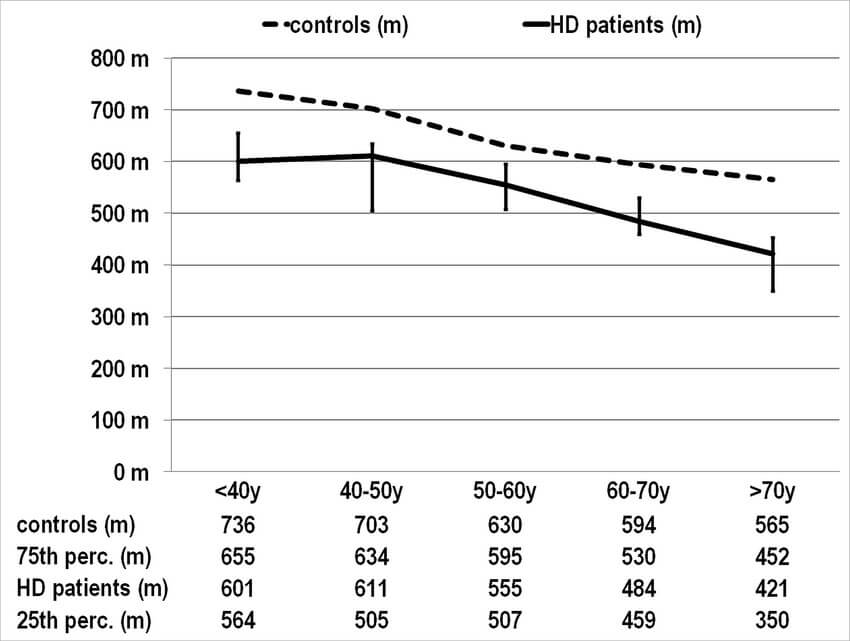6 Minute Walk Test
6 Minute Walk Test
How to use the 6-minute walk test?
There are some steps listed down to get the results.
- Choose your gender.
- Enter your age and height.
- Enter your weight and distance walked.
- Choose the units using the drop-down list.
- By pressing the “calculate” button, you’ll get the results.
What is a 6-minute walk test (6 MWT)?
A six-minute walk test is referred to as a submaximal exercise test in which distance is assessed to test aerobic capacity/ endurance over a span of 6 minutes. This test is to measure the ability of a person to walk over a possible distance in a period of 6 minutes on a hard flat surface.
The main process is to walk for 6 minutes to test the functional exercise tolerance of a person facing chronic respiratory disease and cardiac heart failure. This test is used since 2003 to measure the amount of functional exercise capacity of different people like healthy and non-healthy older adults, people facing knee or hip injuries, fibromyalgia, and scleroderma. This process is also used for children.
Here are some conditions where 6 MWT is applicable:
- Arthritis
- Fibromyalgia
- Geriatrics
- Multiple Sclerosis
- Parkinson’s disease
- Muscle disorders
What is a normal 6-minute walk distance (6MWD)?
Six minute walk test distance is considerably correlated with age (r = -0.29), height (r = 0.393), weight (r = 0.08), and BMI (r = -0.17). However, the values differ from age to age as from 40-85 the average distance is 400-700m/3600sec. People suffering from injuries have reduced 6MWD.
6-minute walk test norms change significantly with people of different countries, age, height, gender, and body weight.
For males the formula for 6MWD is:
6MWD in meters= 6MWD in meters = (7.57 × height in cm) – (5.02 × age) – (1.76 × weight in kg) – 309
The lower limit of normal = 6MWD – 153
For females formula for 6MWD is:
6MWD in meters = (2.11 × height in cm) – (2.29 × weight in kg) – (5.78 × age) + 667
The lower limit of normal = 6MWD – 139
Here are three case studies and tests between people of different age and countries:
Case Study 1
In UK 33 males performed this test aged 55-75 under the standard protocol. Other measurements like leg length, weight, exhaled carbon monoxide, forced expiratory volume in 1 s (FEV1), and physical activities like regular walking.
Results
The average 6MWD was 659±62 m (range 484–820 m). Males walked 59±13 m further than females (P<0.001). Height (r=0.54, P<0.01), weight (r=0.25, P<0.05) and FEV1 (r=0.48, P<0.001) were significantly correlated with 6MWD.
Forwards stepwise multiple lapses showed height (R2=0.294) and FEV1 (R2 change=0.045) to be independent predictors of 6MWD (P<0.05), enlightening 33.9% of the change.
Case Study 2
Children and adolescents aging from 5-17 years performed six MWT in Switzerland. After a short examination of their health and physical activity, the test was performed.
Results
After the 6MWT between different regression models; age, height, and heart rate predicted the distance walked. Age was the most influenced element that predicted that younger children had more walking distance.
Case Study 3
125 subjects from India suffering from chronic heart diseases with Anthropometric variables age, height, body mass, leg length and performed in a 30m corridor.
Results
6MWD significantly correlated with age (r = -0.29), height (r = 0.393), weight (r = 0.08), and BMI (r = -0.17).
Gender equation for Indian individual were: (1) Males: 561.022 - (2.507 × age [years]) + (1.505 × weight [kg]) - (0.055 × height [cm]). R2 = 0.288. (2)
Indian females: 30.325 - (0.809 × age [years]) - (2.074 × weight [kg]) + (4.235 × height [cm]). R2 = 0.272.
The equation although have a large error estimate with a low determination coefficient. The equation concludes the walking capacity of Indian people.
What does a 6-minute walk test measure?
6MWT is used to measure the walking capacity of people when they are suffering from respiratory diseases like asthma, coronary heart disease, and people having problems in their knees and hip bones to administer a person’s perception of dyspnea and oxygen saturation in blood during exertion.
6-minute walk test norms from healthy people are compared with people suffering from diseases. 6MWT norms change significantly on gender, age, leg length, height, and so on.
Here is an example of a different age group with dialysis:
Standard controls: dash lines
HD patients: a straight line.

For what reason is a 6-minute walk test done?
The need for this test has increased to check the health of elderly and disease-affected people. Our online tool is here to help you out, you can easily check the results of 6MWT while sitting in your home.
Here are some quick steps and instructions for the 6-minute walk test in your home:
- Mark a point in a corridor in between 20-50 meters.
- Use a stopwatch to measure time and proceed with the test.
- Record the values
- Entre the recorded values in the tool like distance and other information like height, and age.
- Positive results will show 75% or more than 75%.